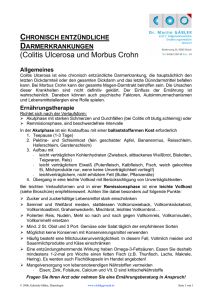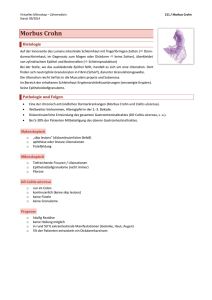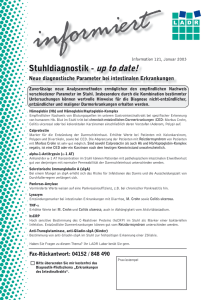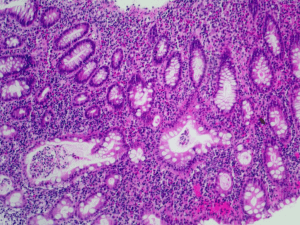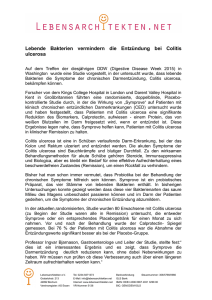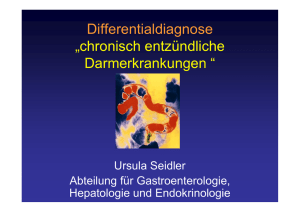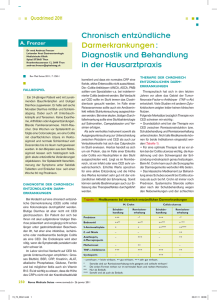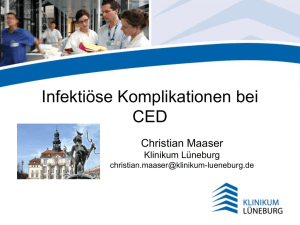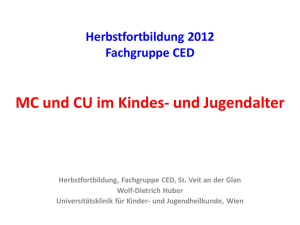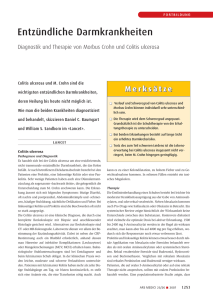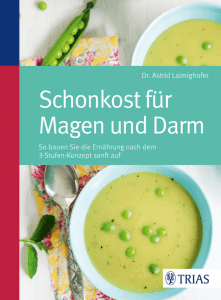2013 CED Greifswald
Werbung
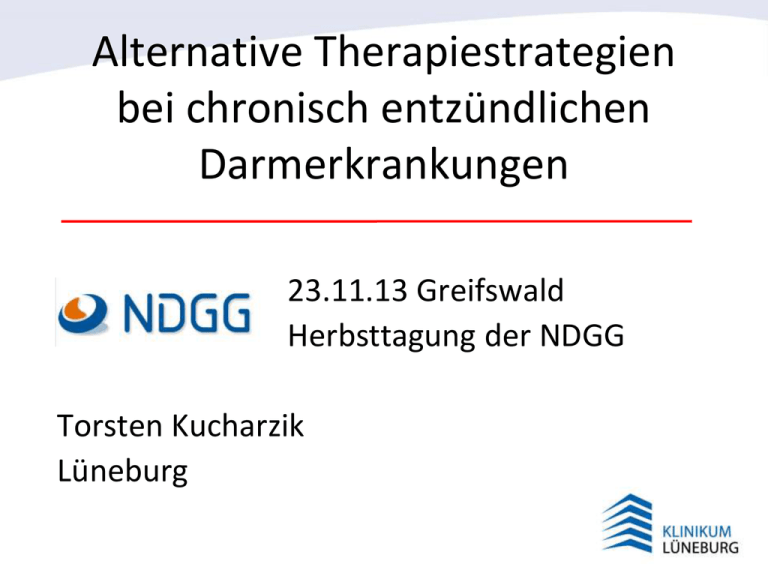
Alternative Therapiestrategien bei chronisch entzündlichen Darmerkrankungen 23.11.13 Greifswald Herbsttagung der NDGG Torsten Kucharzik Lüneburg Akzeleriertes Stufenkonzept zur Therapie des Morbus Crohn + anti-TNF (anti-TNF) Methotrexat Azathioprin Prednisolon Budesonid Mesalazin Chronisch aktiv Remissionserhaltung mit • Azathioprin • Methotrexat • anti-TNF Akut leichtgradig bis schwer S3-Leitlinie der DGVS: Morbus Crohn 2008/2014 ECCO Guidelines J Crohn‘s & Colitis 2010/2014 Sekundäres Therapieversagen von anti-TNF Loss of Response after 12 months therapy (%) 60 50 40 30 20 10 0 Ben-Horim S et Chowers Y. AP&T 2011 Immunogenität und Antikörperbildung (Werte gemäss Fachinformation) Infliximab EU SPC JUL 2011. Adalimumab EU SPC MAR 2011. Certolizumab EU FEB 2011. Golimumab EU SPC AUG 2011. Etanercept EU SPC AUG 2011. Rituximab EU SPC JUN 2011 Ustekinumab EU SPC JUL 2011. Abatacept EU SPC JUN 2011. Tocilizumab SPC 24 AUG 2011 Zur Therapiesteuerung parallele Bestimmung der Talspiegel und Autoantikörper notwendig! Risiko für den Verlust an klinischer Wirksamkeit für Infliximab bei MC-Patienten mit Autoantikörpern (ATIs) RR: 3.2, 95% CI: 1.9-5.5, p<0.0001) N=494, 13 Studien Kavinderjit S et al. Am J Gastro 2012 Spiegelbestimmung von anti-TNF und ADA bei primärem und sekundärem Therapieversagen ADA: anti drug antibodies ADA niedrig Anti-TNF Spiegel niedrig Anti-TNF Spiegel hoch ADA hoch Problem der Bioverfügbarkeit/Pharmakokinetik ADA reduzieren Bioverfügbarkeit Intensivierung der antiTNF-Therapie Wechsel des anti-TNFPräparates Pharmakodynamisches Problem Nicht-neutralisierende ADA Wechsel der Therapie ADA Test wiederholen Bendtzen et al. Scand J Gastro 2009 Kosteneffizienz durch Spiegelbestimmung?! Treatment of Secondary Infliximab Failure in Crohn's Disease Based on Serum Levels of Infliximab and Antibodies Against Infliximab: The Danish Study of Optimizing Infliximab Therapy in Crohn's Disease Steenholdt et al. DDW 2013 Therapieoptimierung/-steuerung bei Thiopurinen Azathioprin XO 6-Mercaptopurin Apoptose HPRT T-Zelle 6-Thioharnsäure TPMT 6-TGN 6-Methylmercaptopurin (6-MMP) Individualisierte Therapie mit Thiopurinen Therapiesteuerung über Metabolite Non-Responder nach 8-12 Wochen (n=63) 6-TGN ↓↓ 6-MMP ↓↓ 6-TGN ↓ 6-MMP ↓ 6-TGN ↓ 6-MMP ↑ 6-TGN ↑ 6-MMP n↑ 7 (11%) 18 (29%) 6 (10%) 33 (52%) Compliance überprüfen Dosis erhöhen Allopurinol +25% Thiopurindosis Verbesserung des Therapieerfolges bei 87% der Non-Responder Therapie wechseln Haines ML, IBD 2011 Alternative Therapiestrategien Neue Crohn-Medikamente am Horizont? Danese S et. al. Gut 2012 Ustekinumab bei aktivem Morbus Crohn n=526, anti-TNF Versager Sandborn et al. NEJM 2012 Autologe hämatopoetische Stammzelltransplantation bei MC • Stammzellmobilisierung mit Cyclophosphamid und G-CSF • Anreicherung ex vivo durch CD34+ Selektion • Reinfusion nach immunsuppressiver Konditionierung mit Cyclophosphamid Clinical relapse free survival (%) 120 100 100 91 n=25 IBD patients 80 63 57 60 39 40 19 20 0 0 1 2 3 years Burt RK et al. Blood 2010 4 5 Allogene mesenchymale Stammzelltransplantation (MSCs) bei MC Zahlreiche laufende Phase II-Studien bei Morbus Crohn und Colitis ulcerosa Van Bokkelen, G. Regen Med. 2011 Antiahäsionsstrategien bei CED - Vedolizumab Vedolizumab bei Morbus Crohn Gemini II Studie Induktionsphase Remissionserhaltung Sandborn B et al; NEJM 2013 PML bei Patienten unter Natalizumab Van Assche G et al. NEJM 2005 Linda H et al. NEJM 2009 Colitis ulcerosa – Erweiterung Kolektomie der „Standardtherapeutika“ Anti-TNF o. Calcineurininhibitoren Azathioprin 6-MP Mesalazin Prednisolon Second Line Rescue First Line Rescue Basistherapie ECCO-Leitlinien, J of Crohn‘s & Colitis 2008 DGVS-Leitlinien, Z Gastroenterologie 2011 Neue Colitis-Medikamente am Horizont? Danese S et. al. Gut 2012 Adalimumab bei aktiver Colitis ulcerosa ULTRA-2 Studie Klinische Remission Woche 8 und Woche 54 n=494 100 Placebo Prozent 80 60 Adalimumab p=0.019 p=0.004 16,5 17,3 NNT=11 p=0.017 p=0.029 21,3 22 NNT=14 p=0.559 p=0.039 9,2 10,2 40 20 9,3 8,5 12,4 11 6,9 3 0 Woche 8 Woche 54 Gesamt Woche 8 Woche 54 TNF-naiv Woche 8 Woche 54 TNF-vorbehandelt Sandborn W et al., Gastroenterology 2012 Golimumab bei Colitis ulcerosa? Phase 2/3, n=1064 Patients with Moderately to Severely Active Ulcerative Colitis: PURSUIT SC/PURSUIT Maintenance Induction, week 6 Maintenance, week 54 100 100 P<0.01 60 40 51 54,9 30,3 20 Response % Response % P<0.01 80 P<0.01 80 P=0.01 60 40 47 49,7 50 mg 100 mg 31,2 20 0 0 Placebo 200/100 mg 400/200 mg Placebo Sandborn et al, Pursuit-SC; Gastroenterology 2013 Sandborn et al, Pursuit-Maintenance; Gastroenterology 2013 Vedolizumab bei Colitis ulcerosa Gemini I Studie Induktionsphase Response Woche 6: 47,1 vs. 25,5% (p<0001) Remissionserhaltung Remission Woche 52: 41,8/44,8 vs. 15,9% (p<0001) Feagan B et al; NEJM 2013 Antiadhäsionsstrategien bei Colitis ulcerosa • • • • • • • • • • Vedolizumab Natalizumab Etrolizumab (rHuMab b7) AJM300 (small molecule, inhibits ICAM-MadCam1) Alicaforsen (anti-ICAM1) DC101 (rHuMab VEGFR-2) PF-547659 ELND-004 ASP-2002 … Second Line Rescue: Tacrolimus bei steroidrefraktärer Colitis ulcerosa? RCT n=62 moderate to severe UC, DAI > 9 Ansprechen/Remission in Woche 8 100 80 p=0.003 p=0.012 60 50 tacrolimus 43,8 placebo 40 NS 20 13,3 13,3 9,4 0 0 clinical response clinical remission mucosal healing Ogata H et al. IBD 2012 Kolektomie freie ÜL-rate Krankheitsaktivität I.v. Cyclosporin vs. Infliximab bei schwerer steroidrefraktärer Colitis ulcerosa Laharie et al. Lancet 2012 Schwere steroidrefraktäre Colitis ulcerosa Hochdosiert Steroide ± Antibiotika Azathioprin -refraktär Azathioprin -naiv Infliximab Cyclosporin*+ AZA Kolektomie * alternativ: Tacrolimus Oraler JAK Kinase Inhibitor Tofacitinib bei Colitis ulcerosa Phase-II Studie, n=194 Sandborn W et al. NEJM 2012 Blocks IL-17/IL-22 Angriff vor Ort: Genetisch modifizierte Bakterien L. lactis IL-10 Phase I Clinical Trial Recombinant microflora 10 patients: 5 remission, 3 response regulator Steidler et al. Science 2000 Braat et al Clin Gastro Hepatol 2006 Barriere und Mikrobiota bei CED Mikrobiota Defensine Tight junctions Wundheilung durch Wachstumsfaktoren Trefoil-Faktoren PGE2 sIgA Mukus (enthält Phosphatidylcholin) Phosphatidylcholin zur Stärkung der intestinalen Barriere bei Colitis ulcerosa? Antigene Bakterien Defensine Tight junctions Trefoil factor PGE2 Wundheilung KGF TGF-b FGF GM-CSF Mukus (enthält Lecithine) IgA sIgA Phosphatidylcholin bei Colitis ulcerosa? Phase-IIb Studie, n=153 Mesalazin-refraktäre CU-Patienten Clinical Remission (%) 50 P<0.05 40 31,4 30 20 15 10 0 Placebo Karner M et al. DDW 2012 Karner M et al. UEGW 2012 LT02 3.2g Stuhltransplantation auch bei CED? Stuhltransplantation bei therapierefraktärer Clostridium difficile Infektion Van Nood et al, NEJM, 2013 Stuhltransplantation auch bei CED? • Primärtherapie bei CED? Nur im Rahmen von Studien! • Therapie bei refraktärer C. diff. Infektion bei CED? Ggf. Ja! Aktuelle Studie bei CED-Patienten mit refraktärer C.diff-Infektion: n=36, duodenale Infusion 1x: 19%, 2x: 39%, 3x: 43% 89% patients in clinical remission, C.diff. Toxin disappeared Borody et al. UEGW 2013 Immunmodulation durch Tripeptide? KPV stimulation of melanocytes K P V antipyretic antimicrobial antiinflammatory immunomodulative ------> K (d)P T Lys-Pro-Val ------> Lys-d-Pro-Thr KdPT has antiinflammatory properties in different models of colitis DSS-Colitis, KdPT orally Transfer Colitis TNBS colitis IL-10 deficient mice … Maaser C et al., Gut 2006 Kannengiesser K et al., Inflam Bowel Dis 2008 Brzoska T et al, Eur J Clin Invest 2011 Bettenworth D et al., Am J Pathology 2011 Tripeptid KdPT bei Colitis ulcerosa Phase IIa Studie, n=120, multizentrisch, placebokontrolliert p=0.0095 p=0.0296 Kucharzik/Maaser et al., unpublished data Alternative Therapiestrategien bei CED - Fazit • Individualisierte Therapie – „Spiegel statt spiegeln“ • Antiadhäsionsstrategien – Vedolizumab und mehr • Noch mehr Targets… • • JAK-Inhibition (Tofacitinib) Interleukine, Chemokinrezeptoren… • Angriff vor Ort - genetisch mod. Bakterien, Nanotechnologie… • Barriere stärken - Phosphatidylcholin • Mikrobiom verändern – Stuhltransplantation, Helminthen… risk of a flare (%) Nikotinkonsum und Morbus Crohn Cosnes et al., 2001 Clinical Gastroenterology and Hepatology Naftali et. al. Clin Gastro Hepatol 2013; 1276
